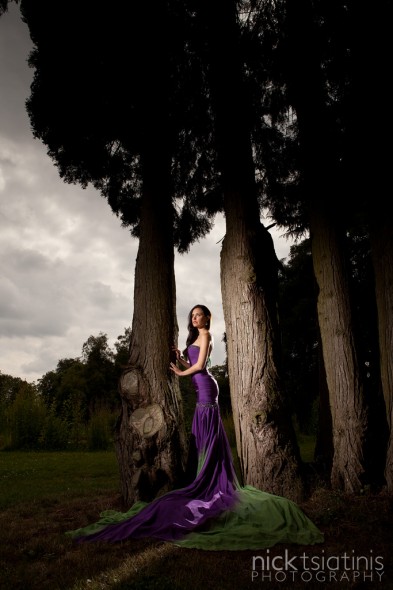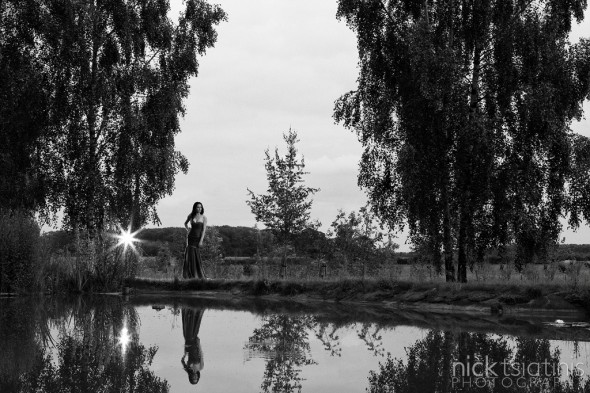14
2011Into The Light with Damien Lovegrove and Martin Hill
As ever so slightly teased yesterday evening, I spent all day yesterday on a workshop hosted by the super pairing of Damien Lovegrove and Martin Hill called ‘Into The Light’ which took place at Kingscote House in Gloucestershire.
The aim of the course was to learn and practice both natural light (which I’ve been getting into in a big way recently) and ‘big flash’ outdoors. As (at the time of booking) I’d really been neglecting natural light, and because I love the effects that big flash can give you and I have a barely used Lencarta Safari portable flash system I was looking forward to getting my inspiration reignited and venturing into new photographic territories.
The day started with a quick introduction from Martin about what the aims would be for the day – this was summed up simply by him wanting us to create lickable photographs – those which are so good that when you see them you have absolutely no idea what to do – so you just lick them… Brilliant!
From there, Damien gave us a quick introduction and talk before we split off into two groups of five photographers (which was pretty much on a Nikon / Canon split). The plan was for each group to spend around 90 minutes with either Damien or Martin, then switch for the next 90 minutes, then lunch and repeat again. Those with Damien would be practising the art of natural (and faux natural) lighting indoors, and those with Martin would be using flash outdoors.
I was with the Canon guys, and we started off upstairs in the fantastic country house location with Damien and our model Iskra. We began in one of the bedrooms where Damien showed us the natural light streaming through the big windows, and how it fell on our model to create light and shade. He also showed us the rather nice Lupo 800 light – a daylight balanced spotlight which can be used very effectively with natural light to just add a bit of an accentuation to the scene without resulting in ugly colour casts. With Iskra posing beautifully on the bed, our group took advantage of the natural (and not so natural) lighting to get some great portraits.
From the bedroom we moved into the bathroom with Iskra having a quick costume change in the process. Here Damien showed us how to balance the natural light coming through the window with the absolutely awesome Lupo 1200 spotlight (which I am totally sold on and WILL be buying next time I have a spare £1000!) in order to counteract the strong light coming through the window, still giving a natural look and retaining detail in the outside scene (something that I’d found wasn’t possible just using a reflector). In order to do this, Damien used a rather nifty Manfrotto superclamp solution to quite literally clamp the Lupo to the top of the bathroom door – thus proving that you really do not need huge amounts of space to create gorgeous, natural photography!
After we’d finished in the bathroom it was time for a quick coffee break before we went outdoors with Martin to work with the high powered Broncolor 1200W portable flash system. Our model for this part was Sarah, who was modelling in a wedding dress in order to give us an idea of some different, fresh and dramatic shots we could all get in a wedding situation – even at 11am!
The first thing I need to point out here is Martins enthusiasm – boy does this chap have it in bundles. It was hard not to get inspired with Martin tutoring you – he clearly loves his work, and it shows in the quality he produces, and gets you to produce.
Starting off with a simple one light setup we used one Bron head firing through a strip softbox, underexposing the sky for drama, but maintaining perfect exposure on Sarah and – most importantly – the dress.
As a stark contrast, after we had finished with the flash and before we moved onto the next scene we took a few shots using natural light only – and the results couldn’t be more different!
From here we moved onto another ‘set’ and another technique – balancing two lights to add a bit of an accent on our bride – and also to take more of a grand vista. Again we were using the Bron kit, but positioning one light to the left of our model and slightly in front of her, with the second light being to the right and slightly behind.
After we’d done one final set, using a nice retro style bench it was time for lunch (and a quick recharge of the Bron’s batteries!)
Just as a quick aside before I get back into the course overview – I was expecting the typical ‘sandwiches and nibbles’ fayre which is oh so cliche of usual lunchtime catering. What I ended up getting was some braised lamb chops, with roast potatoes and veg. Fantastic! Could not have asked for anything better – full credit to Blaise and the Lovegrove Consulting crew for sorting out a proper meal for the delegates when the easy way would have been to call in the prawn sandwich crew!
Moving on quickly!
After lunch we headed back outdoors with Martin to do some work with standard speedlights and PocketWizards using TTL metering. Now, I’ll admit that I had absolutely no idea how this little piece of Japanese trickery works, and despite asking many questions I’m still no closer to the answer – however what can’t be denied is that the results work beautifully. Maybe it’s because I’ve been brought up to have full control over my flash equipment that’s confusing me by just leaving it to technology but there you go. I think I’ll be sticking to my manual stuff in the future though!
Anyway, we were back outside with Sarah, who had had a quick costume change during the break and was now wearing a fantastic purple and green dress. We identified a small row of trees as our first set – using a two speedlight setup similar to how we had previously used the massively more powerful Brons earlier. Japanese trickery started producing some awesome results…
From the trees we then moved in to an awesome walled garden, using three speedlights to throw light strategically to light the front of our model, her hair (to make her stand out from the background) and the stunningly intricate door at the back of the garden.
After finishing in the garden we moved out to the lake in the grounds to take one, final, BIG shot using the now recharged Brons in a two light setup (which meant that my confused brain was happier knowing we were back to manual settings!). Taking care to frame Sarah properly and to capture her reflection beautifully in the lake the shot was taken, and our tuition with Martin was over.
Another quick coffee break later and we were back upstairs with Damien and Iskra. This time we moved into one of the other bedrooms where Damien drew the curtains to create the smallest slivers of light and an amazing low key setting.
Moving into the ample hallway, Damien then brought out the Lupo 1200 again in order to enhance the (substantial) lack of available light in the area. Cleverly, he then showed us a technique of using a small venetian blind directly in front of the Lupo as a gobo in order to create some beautiful shadows on Iskra. Who said natural light actually had to be natural?
Before moving from this room, Damien gave quite possibly the best lesson I had ever learned regarding how to tell where the light was coming from – simply point a finger directly downwards and rest it on the carpet – the resulting shadow gives everything away. Sounds obvious? It certainly is, but moving your finger less than a foot left and right can show that the light is coming from two completely different sources – and you can only control the light once you know where it’s coming from!
Moving on to another of the bedrooms in the house, Damien showed yet another trick, taking some silver coloured, crumpled material and reflecting the Lupo off it and directly onto our model to create a faux foliage / water / dappled effect on Iskra and the wall.
In the same room we took full advantage of the gorgeous shutters across the window to completely blow the backlight and make some stunning beauty shots of Iskra.
As time was now running out rapidly we moved back into the hallway to create some final, beautiful images with Iskra posing in the doorframe at the end of the hall, with a huge natural backlight (no Lupo here!)
As is typical with my shots, the final one of the day ended up being a complete and utter corker – Iskra posing beautifully, my 100mm L Macro lens performing to its best and the light being such a welcome addition, creating a beautiful contrast between light and shadow and a fantastic photograph.
So that was it – after packing my kit and having a quick, informal chat with Damien regarding marketing my photography it was into the kitchen for a quick debrief before setting off home after naturally giving my sincere thanks to Damien and Martin.
It was an interesting course, one which surprisingly the more I look back on the more I’m picking up invaluable ideas and techniques from – and once which has suitably reinforced my existing knowledge as well as giving me new knowledge and ideas which I can take forward to my customers to provide extra value and quality in their shoots, whether weddings or portraits.
Damien, Martin – thank you, and I sincerely hope we have the pleasure of meeting again.


























Martin Pemberton
A great review of the course, one I might well find myself on in the near future and great images for the portfolio too
Dan
Great review Nick and gorgeous pics – I attended a Lovegrove Winter Weddings workshop last year and it was worth every penny, and I’m seriously tempted to sign up to this one too 🙂
Into The Light with Martin Hill - Workshop | Nick Tsiatinis Wedding Photography
[…] full write up can be found on my portraits site, but as part of the off-camera flash tuition we experimented with how we could add a bit of mood […]